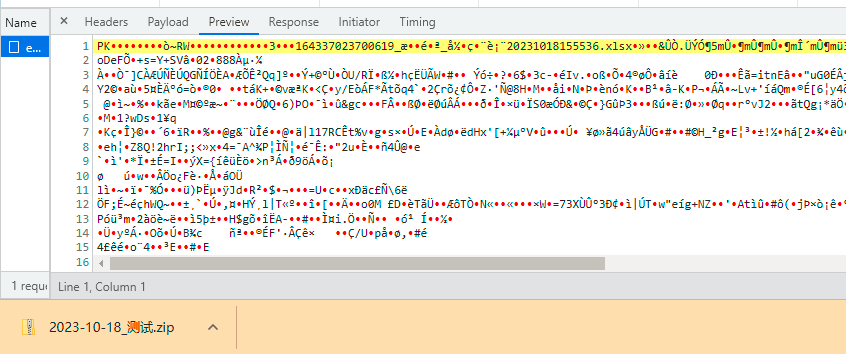使用jdk自带的zip包下的类来实现压缩
1.实体类
实体类主要是文件名和文件路径(base64字符串),压缩文件路径时可以不使用类里的文件名。
import lombok.Data;
@Data
public class FileInfoDto {
/**文件名*/
private String fileName;
**文件路径或base64字符串*/
private String file;
}
2.工具类
创建和删除文件的方式来辅助压缩,在创建一个zip文件时,每个zipEntry代表zip文件中的一个项,zipEntry的名称在zip文件内必须是唯一的,因为zip文件格式使用这些条目名称作为查找键,来定位和提取存储在zip中的文件。所以名称相同时会抛出异常,我这里在调用前做了处理。
我省略了项目路径的import,使用时导入自己的路径即可。
import org.springframework.core.io.ClassPathResource;
import javax.servlet.http.HttpServletResponse;
import java.io.File;
import java.io.FileInputStream;
import java.io.FileOutputStream;
import java.io.IOException;
import java.io.InputStream;
import java.io.OutputStream;
import java.net.URL;
import java.net.URLDecoder;
import java.net.URLEncoder;
import java.nio.file.Files;
import java.nio.file.Paths;
import java.time.LocalDate;
import java.time.format.DateTimeFormatter;
import java.util.Base64;
import java.util.List;
import java.util.zip.ZipEntry;
import java.util.zip.ZipOutputStream;
/**
* @author xxx
* @date 2023/10/18 14:43
* @description:
*/
public class BaseZipUtils {
/**
* 使用给定的文件列表创建ZIP文件并将其发送到HTTP响应。
*
* @param response HttpServletResponse
* @param fileList 文件列表
* @param title ZIP文件的标题
* @param type 1-base64压缩,2-url-压缩
*/
public static void downZipFile(HttpServletResponse response, List<FileInfoDto> fileList, String title, Integer type) {
// 获取模板路径,并构建ZIP文件的完整路径。
String tempDirPath = getTemplatePath();
File zipFilePath = new File(tempDirPath, LocalDate.now().format(DateTimeFormatter.ofPattern("yyyy-MM-dd")) + "_" + title);
try {
if (1 == type) {
// 基于Base64编码的文件创建ZIP文件。
zipFiles(fileList, zipFilePath);
} else {
zipFilesFromURLs(fileList, zipFilePath);
}
// 如果ZIP文件存在,将其发送到HTTP响应。
if (zipFilePath.exists()) {
try (InputStream is = new FileInputStream(zipFilePath);
OutputStream os = response.getOutputStream()) {
response.setContentType("application/octet-stream");
response.setHeader("Content-disposition", "attachment; filename=" + URLEncoder.encode(zipFilePath.getName(), "UTF-8"));
// 从ZIP文件读取内容并写入HTTP响应。
byte[] buffer = new byte[4096];
int bytesRead;
while ((bytesRead = is.read(buffer)) != -1) {
os.write(buffer, 0, bytesRead);
}
} finally {
// 删除临时ZIP文件。
Files.deleteIfExists(zipFilePath.toPath());
}
}
} catch (Exception e) {
e.printStackTrace();
}
}
/**
* 将Base64编码的文件列表压缩为一个ZIP文件。
*
* @param srcFiles 需要压缩的文件列表
* @param zipFile 生成的ZIP文件
*/
public static void zipFiles(List<FileInfoDto> srcFiles, File zipFile) throws IOException {
// 如果ZIP文件不存在,创建它。
if (!zipFile.exists()) {
Files.createFile(zipFile.toPath());
}
try (ZipOutputStream zos = new ZipOutputStream(new FileOutputStream(zipFile))) {
for (FileInfoDto fileInfo : srcFiles) {
// 解码文件名。
String fileName = URLDecoder.decode(fileInfo.getFileName(), "UTF-8");
// 创建ZIP条目并添加到ZIP输出流中。
ZipEntry entry = new ZipEntry(fileName);
zos.putNextEntry(entry);
// 将Base64编码的文件内容解码为字节数组。
byte[] fileBytes = Base64.getDecoder().decode(fileInfo.getFile());
// 将字节数组写入ZIP文件。
zos.write(fileBytes);
zos.closeEntry();
}
}
}
/**
* 使用从URL获取的文件列表创建ZIP文件。
*
* @param srcFilesURLs 需要压缩的文件URL列表
* @param zipFile 生成的ZIP文件
*/
public static void zipFilesFromURLs(List<FileInfoDto> srcFilesURLs, File zipFile) throws IOException {
// 如果ZIP文件不存在,创建它。
if (!zipFile.exists()) {
Files.createFile(zipFile.toPath());
}
try (ZipOutputStream zos = new ZipOutputStream(new FileOutputStream(zipFile))) {
for (FileInfoDto dto : srcFilesURLs) {
URL url = new URL(dto.getFile());
// 获取文件的文件名。
String fileName = Paths.get(url.getPath()).getFileName().toString();
// 创建ZIP条目并添加到ZIP输出流中。
ZipEntry entry = new ZipEntry(fileName);
zos.putNextEntry(entry);
// 从URL读取文件内容。
try (InputStream is = url.openStream()) {
byte[] buffer = new byte[4096];
int bytesRead;
while ((bytesRead = is.read(buffer)) != -1) {
// 将从URL读取的内容写入ZIP文件。
zos.write(buffer, 0, bytesRead);
}
}
zos.closeEntry();
}
}
}
/**
* 获取类路径的绝对地址。
*
* @return 类路径的绝对地址
*/
public static String getTemplatePath() {
try {
String realPath = new ClassPathResource("").getURL().getPath();
return URLDecoder.decode(realPath, "UTF-8");
} catch (Exception e) {
e.printStackTrace();
return null;
}
}
}
3.js接收blob
/**
* 处理Blob响应并触发浏览器下载。
* @param {Object} res - 包含头信息和数据的响应对象。
* @param {string} [name] - 下载文件的可选名称。
* @param {string} [type2] - Blob的可选类型。
*/
export const handleBlob = (res, name, type2) => {
// 从提供的名称或响应头中获取文件名
const fileName = name || (res.headers['content-disposition'] &&
decodeURI(res.headers['content-disposition'])
.split('filename=')[1]);
// 从提供的type2或响应头中获取类型
const type = type2 || res.headers['content-type'];
// 创建Blob对象
const blob = new Blob([res.data], { type });
// 触发浏览器下载
const downloadElement = document.createElement('a');
downloadElement.href = window.URL.createObjectURL(blob);
downloadElement.download = fileName; // 设置下载文件的名称
document.body.appendChild(downloadElement);
downloadElement.click();
document.body.removeChild(downloadElement);
}
4.调用
String title = "测试.zip";
BaseZipUtils.downZipFile(response, fileList, title,1);
调用结果:

所谓无底深渊,下去,也是前程万里。 – 木心























 4087
4087











 被折叠的 条评论
为什么被折叠?
被折叠的 条评论
为什么被折叠?








